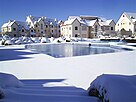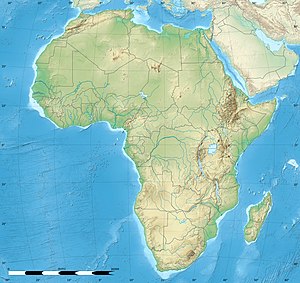This article needs additional citations for verification. (January 2023) |
Ifrane
إفران | |
|---|---|
Ifrane in winter (Clockwise from top: Chalet-style apartments; a road through the forest; a barbary macaque in the forest; the campus of Al Akhawayn University) | |
 Openstreetmap of Ifrane | |
| Coordinates: 33°32′N 5°07′W / 33.533°N 5.117°W | |
| Country | Morocco |
| Region | Fès-Meknès |
| Government | |
| • Mayor | Abdeslam Lahrar |
| Elevation | 1,665 m (5,460 ft) |
| Population (2014)[2] | |
| • Total | 14,659 |
| Time zone | UTC+1 (CET) |
Ifrane (Arabic: إفران) is a city in the Middle Atlas region of northern Morocco (population 14,659 as of November 2014).[2] The capital of Ifrane Province in the region of Fès-Meknès, Ifrane is located at an elevation of 1,665 m (5,463 ft).[1] In the regional Tamazight language, "ifran" means caves.
The modern town of Ifrane was established by the French administration in 1928 during the protectorate era for their administration due to its Alpine climate. Ifrane was conceived as a "hill station" or colonial type of settlement. It is a resort town set high up in the mountains so that Europeans could find relief from the summer heat of the interior plains of Morocco. Ifrane, the house of Lake Dayet Iffer is also a popular altitude training destination.[3]
The first permanent settlement of the area dates to the 16th century, when the Sharif Sîdî 'Abd al-Salâm established his community in the Tizguit Valley, seven km downstream from the present town. Ifrane is a colonial "hill station", and a "garden city". It is also an "imperial city", a mountain resort, a provincial administrative center, and a college town.
- ^ a b "Climatological Information for Ifrane, Morocco", Hong Kong Observatory, 2003, web: HKO-Ifrane.
- ^ a b "POPULATION LÉGALE DES RÉGIONS, PROVINCES, PRÉFECTURES, MUNICIPALITÉS, ARRONDISSEMENTS ET COMMUNES DU ROYAUME D'APRÈS LES RÉSULTATS DU RGPH 2014" (in Arabic and French). High Commission for Planning. 8 April 2015. Retrieved 29 September 2017.
- ^ Egan, E. Notes from higher grounds: an altitude training guide for endurance athletes, Kukimbia Huru Publishing






